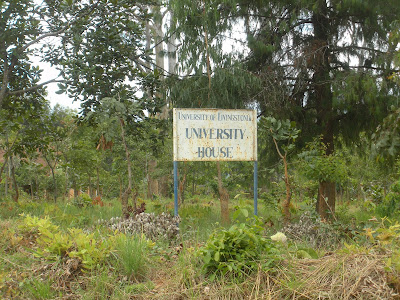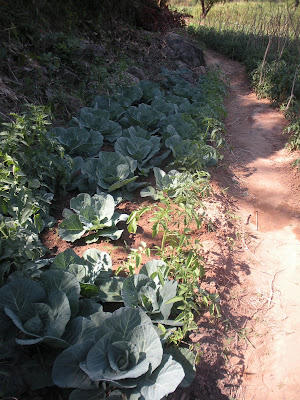On Friday July 7th, Karyn and I continued south from Blantyre via minibus to go to Mt. Mulanje, also called Mulanje Massif. It is a huge tourist draw in Malawi and is essentially a enormous plateau made of granite. It reminded me a lot of Yosemite Valley because it was made out of granite, has vertical rock faces, and simply looked like it could fit in there. This is a popular rock climbing area because of the vertical walls and good quality granite. The base of Mt. Mulanje is at about 3000 feet and the goes up 3000 vertical feet to the plateau, so most of the plateau is at 6000 feet. The cool thing though is that there are many peaks that tower over the main plateau, and the highest point is about 9000 feet and called Sapitwa Peak. When I say that Mt. Mulanje goes straight up, I mean it. The trails do not switchback or meander but go the most direct route from point A to point B regardless of the elevation or grade. We were heading there to run in a porter’s race that went up and down the mountain and to do a three day trek after the race.
The ride to Mulanje was mostly uneventful except when the minibus driver went through a tea plantation to avoid a police checkpoint. I really thought we would end up stuck on the dirt road, but the minibus driver masterfully navigated the deeply rutted and steep roads (Side note: All the minibus drivers, while they may drive like maniacs, are experts and can successfully drive their vehicles on any type of road). The weather around Mt. Mulanje is perfect for growing tea plants so the base of the mountain is covered in them. There are many tea plantations and processing plants that surround the mountain also. All the tea plants make the area really beautiful because the sea of light green next to the grey of the granite.
After stopping at the visitor center in the main town of the area (which is not surprisingly called Mulanje) to get more info about the race and trekking, we took motorcycles to a town called Likhubula where the race began the next day. We checked into our hostel, organized our trek with the local forestry office (they help organize the local guides and is who you pay to camp on the mountain), and walked around to see what there was.
Mt. Mulanje is famous for its cedar trees so the local curio market sells lots of cedar things and very cheap. I bought a medium sized hinged box for about $2. A great deal but not the best choice in regards to deforestation. One major issue for Malawi and Africa in general is how fast forested regions are currently being cut down (Side note: Zambia is number 3 on the list of counties with the fastest deforestation). Locals use trees for cooking fuel and to heat their homes and much of the wood is used to make wooden knick knacks for tourists.
After walking through the really small market and helping Karyn get a local tailor to make some skirts made of local fabrics, we headed back to the hostel to relax and prepare for the race the next day. Along the way, we met Asa, an Israeli, who wanted to be a part of our trek up the mountain. As the day went on, there were more and more Azungus coming into town and any potential place to spend the night was booked because everyone was here for the Mt. Mulanje Porter’s Race the next day.
I’ll talk about the race in my next post because it was such an experience. Lots of random things happened during this fun experience.
 |
| Women caring wood down the mountain |
 |
| View of Mt. Mulanje from Sapitwa Peak |
 |
| Me on a motorcycle |
 |
| Driving through a market town on market day |














































